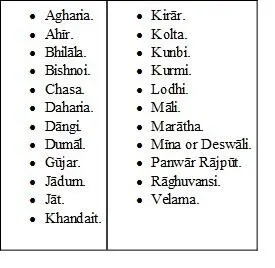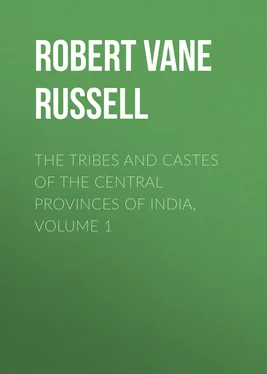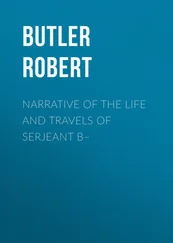Robert Vane Russell - The Tribes and Castes of the Central Provinces of India, Volume 1
Здесь есть возможность читать онлайн «Robert Vane Russell - The Tribes and Castes of the Central Provinces of India, Volume 1» — ознакомительный отрывок электронной книги совершенно бесплатно, а после прочтения отрывка купить полную версию. В некоторых случаях можно слушать аудио, скачать через торрент в формате fb2 и присутствует краткое содержание. Жанр: foreign_prose, История, foreign_edu, foreign_antique, на английском языке. Описание произведения, (предисловие) а так же отзывы посетителей доступны на портале библиотеки ЛибКат.
- Название:The Tribes and Castes of the Central Provinces of India, Volume 1
- Автор:
- Жанр:
- Год:неизвестен
- ISBN:нет данных
- Рейтинг книги:5 / 5. Голосов: 1
-
Избранное:Добавить в избранное
- Отзывы:
-
Ваша оценка:
- 100
- 1
- 2
- 3
- 4
- 5
The Tribes and Castes of the Central Provinces of India, Volume 1: краткое содержание, описание и аннотация
Предлагаем к чтению аннотацию, описание, краткое содержание или предисловие (зависит от того, что написал сам автор книги «The Tribes and Castes of the Central Provinces of India, Volume 1»). Если вы не нашли необходимую информацию о книге — напишите в комментариях, мы постараемся отыскать её.
The Tribes and Castes of the Central Provinces of India, Volume 1 — читать онлайн ознакомительный отрывок
Ниже представлен текст книги, разбитый по страницам. Система сохранения места последней прочитанной страницы, позволяет с удобством читать онлайн бесплатно книгу «The Tribes and Castes of the Central Provinces of India, Volume 1», без необходимости каждый раз заново искать на чём Вы остановились. Поставьте закладку, и сможете в любой момент перейти на страницу, на которой закончили чтение.
Интервал:
Закладка:
Thus all the castes of the first group are derived from the representatives of the Brāhmans and Kshatriyas, the two highest of the four classical castes, except the Guraos, who have risen in status owing to special circumstances. The origin of the Kāyasths is discussed in the article on that caste. Members of the above castes usually wear the sacred thread which is the mark of the Dwija or twice-born, the old Brāhmans, Kshatriyas and Vaishyas. The thread is not worn generally by the castes of the second group, but the more wealthy and prominent sections of them frequently assume it.
20. Castes from whom a Brāhman can take water. Higher agriculturists
The second group of good castes from whom a Brāhman can take water falls into three sections as already explained: the higher agricultural castes, the higher artisans, and the serving or menial castes from whom a Brāhman takes water from motives of convenience. These last do not properly belong to the second group but to the next lower one of village menials. The higher agricultural castes or those of the first section are noted below:

In this division the Kurmis and Kunbis are the typical agricultural castes of Hindustān or the plains of northern India, and the Bombay or Marātha Deccan. Both are very numerous and appear to be purely occupational bodies. The name Kurmi perhaps signifies a cultivator or worker. Kunbi may mean a householder. In both castes, groups of diverse origin seem to have been amalgamated owing to their common calling. Thus the Kunbis include a subcaste derived from the Banjāra (carriers), another from the Dhangars or shepherds, and a third from the Mānas, a primitive tribe. In Bombay it is considered that the majority of the Kunbi caste are sprung from the non-Aryan or indigenous tribes, and this may be the reason why Marātha Brāhmans do not take water from them. But they have now become one caste with a status equal to that of the other good cultivating castes. In many tracts of Berār and elsewhere practically all the cultivators of the village belong to the Kunbi caste, and there is every reason to suppose that this was once the general rule and that the Kunbis or ‘householders’ are simply the cultivators of the Marātha country who lived in village communities. Similarly Sir H. Risley considered that some Kurmis of Bihār were of the Aryan type, while others of Chota Nāgpur are derived from the indigenous tribes. The Chasas are the cultivating caste of Orissa and are a similar occupational group. The word Chasa has the generic meaning of a cultivator, and the caste are said by Sir H. Risley to be for the most part of non-Aryan origin, the loose organisation of the caste system among the Uriyas making it possible on the one hand for outsiders to be admitted into the caste, and on the other for wealthy Chasas, who gave up ploughing with their own hands and assumed the respectable title of Mahanti, to raise themselves to membership among the lower classes of Kāyasths. The Koltas are another Uriya caste, probably an offshoot of the Chasas, whose name may be derived from the kulthi 47 47 Dolichos uniflorus .
pulse, a favourite crop in that locality.
Similarly the Vellālas are the great cultivating caste of the Tamil country, to whom by general consent the first place in social esteem among the Tamil Sūdra castes is awarded. In the Madras Census Report of 1901 Mr. Francis gives an interesting description of the structure of the caste and its numerous territorial, occupational and other subdivisions. He shows also how groups from lower castes continually succeed in obtaining admission into the Vellāla community in the following passage: “Instances of members of other castes who have assumed the name and position of Vellālas are the Vettuva Vellālas, who are only Puluvāns; the Illam Vellālas, who are Panikkāns; the Karaiturai (lord of the shore) Vellālas, who are Karaiyāns; the Karukamattai (palmyra leaf-stem) Vellālas, who are Balijas; the Guha (Rama’s boatmen) Vellālas, who are Sembadavāns; and the Irkuli Vellālas, who are Vannāns. The children of dancing-girls also often call themselves Mudali, and claim in time to be Vellālas, and even Paraiyāns assume the title of Pillai and trust to its eventually enabling them to pass themselves off as members of the caste.”
This is an excellent instance of the good status attaching to the chief cultivating caste of the locality and of the manner in which other groups, when they obtain possession of the land, strive to get themselves enrolled in it.
The Jāts are the representative cultivating caste of the Punjab. They are probably the descendants of one of the Scythian invading hordes who entered India shortly before and after the commencement of the Christian era. The Scythians, as they were called by Herodotus, appear to have belonged to the Mongolian racial family, as also did the white Huns who came subsequently. The Gūjar and Ahīr castes, as well as the Jāts, and also the bulk of the existing Rājpūt clans, are believed to be descended from these invaders; and since their residence in India has been comparatively short in comparison with their Aryan predecessors, they have undergone much less fusion with the general population, and retain a lighter complexion and better features, as is quite perceptible to the ordinary observer in the case of the Jāts and Rājpūts. The Jāts have a somewhat higher status than other agricultural castes, because in the Punjab they were once dominant, and one or two ruling chiefs belonged to the caste. 48 48 See article Jāt for a more detailed discussion of their status.
The bulk of the Sikhs were also Jāts. But in the Central Provinces, where they are not large landholders, and have no traditions of former dominance, there is little distinction between them and the Kurmis. The Gūjars for long remained a pastoral freebooting tribe, and their community was naturally recruited from all classes of vagabonds and outlaws, and hence the caste is now of a mixed character, and their physical type is not noticeably distinct from that of other Hindus. Sir G. Campbell derived the Gūjars from the Khazars, a tribe of the same race as the white Huns and Bulgars who from an early period had been settled in the neighbourhood of the Caspian. They are believed to have entered India during the fifth or sixth century. Several clans of Rājpūts, as well as considerable sections of the Ahīr and Kunbi castes were, in his opinion, derived from the Gūjars. In the Central Provinces the Gūjars have now settled down into respectable cultivators. The Ahīrs or cowherds and graziers probably take their name from the Abhīras, another of the Scythian tribes. But they have now become a purely occupational caste, largely recruited from the indigenous Gonds and Kawars, to whom the business of tending cattle in the jungles is habitually entrusted. In the Central Provinces Ahīrs live in small forest villages with Gonds, and are sometimes scarcely considered as Hindus. On this account they have a character for bucolic stupidity, as the proverb has it: ‘When he is asleep he is an Ahīr and when he is awake he is a fool.’ But the Ahīr caste generally has a good status on account of its connection with the sacred cow and also with the god Krishna, the divine cowherd.
The Marāthas are the military caste of the Marātha country, formed into a caste from the cultivators, shepherds and herdsmen, who took service under Sivaji and subsequent Marātha leaders. The higher clans may have been constituted from the aristocracy of the Deccan states, which was probably of Rājpūt descent. They have now become a single caste, ranking somewhat higher than the Kunbis, from whom the bulk of them originated, on account of their former military and dominant position. Their status was much the same as that of the Jāts in the Punjab. But the ordinary Marāthas are mainly engaged in the subordinate Government and private service, and there is very little distinction between them and the Kunbis. The Khandaits or swordsmen (from khanda , a sword) are an Uriya caste, which originated in military service, and the members of which belonged for the most part to the non-Aryan Bhuiya tribe. They were a sort of rabble, half military and half police, Sir H. Risley states, who formed the levies of the Uriya zamīndārs. They have obtained grants of land, and their status has improved. “In the social system of Orissa the Sreshta (good) Khandaits rank next to the Rājputs, who are comparatively few in number, and have not that intimate connection with the land which has helped to raise the Khandaits to their present position.” 49 49 Tribes and Castes of Bengal , art. Khandait.
The small Rautia landholding caste of Chota Nāgpur, mainly derived from the Kol tribe, was formed from military service, and obtained a higher status with the possession of the land exactly like the Khandaits.
Интервал:
Закладка:
Похожие книги на «The Tribes and Castes of the Central Provinces of India, Volume 1»
Представляем Вашему вниманию похожие книги на «The Tribes and Castes of the Central Provinces of India, Volume 1» списком для выбора. Мы отобрали схожую по названию и смыслу литературу в надежде предоставить читателям больше вариантов отыскать новые, интересные, ещё непрочитанные произведения.
Обсуждение, отзывы о книге «The Tribes and Castes of the Central Provinces of India, Volume 1» и просто собственные мнения читателей. Оставьте ваши комментарии, напишите, что Вы думаете о произведении, его смысле или главных героях. Укажите что конкретно понравилось, а что нет, и почему Вы так считаете.












